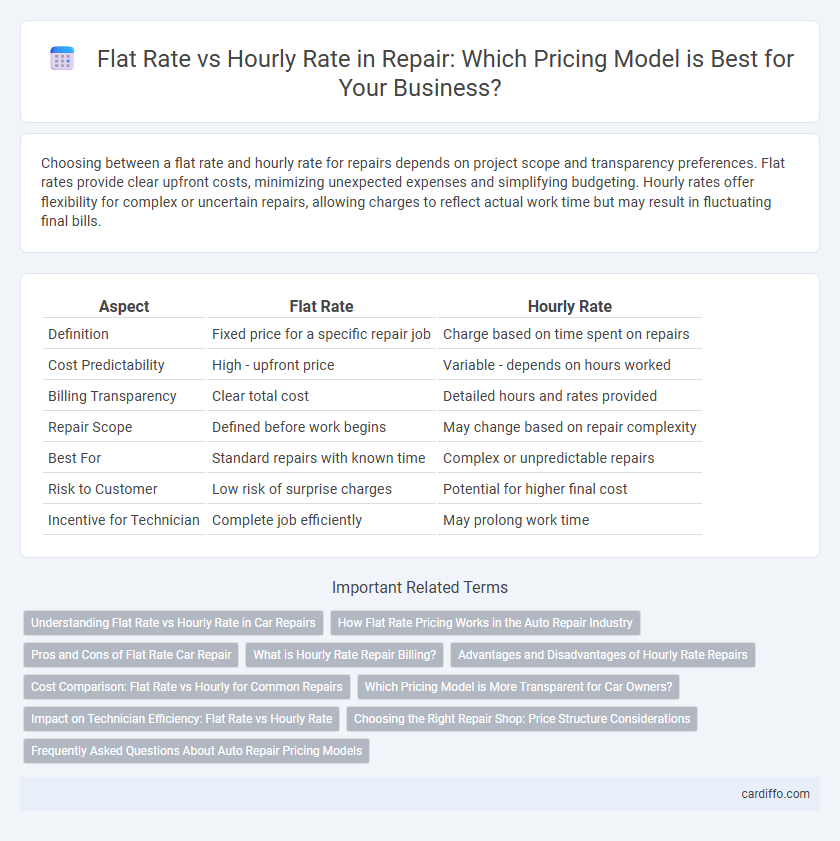Choosing between a flat rate and hourly rate for repairs depends on project scope and transparency preferences. Flat rates provide clear upfront costs, minimizing unexpected expenses and simplifying budgeting. Hourly rates offer flexibility for complex or uncertain repairs, allowing charges to reflect actual work time but may result in fluctuating final bills.
Table of Comparison
| Aspect | Flat Rate | Hourly Rate |
|---|---|---|
| Definition | Fixed price for a specific repair job | Charge based on time spent on repairs |
| Cost Predictability | High - upfront price | Variable - depends on hours worked |
| Billing Transparency | Clear total cost | Detailed hours and rates provided |
| Repair Scope | Defined before work begins | May change based on repair complexity |
| Best For | Standard repairs with known time | Complex or unpredictable repairs |
| Risk to Customer | Low risk of surprise charges | Potential for higher final cost |
| Incentive for Technician | Complete job efficiently | May prolong work time |
Understanding Flat Rate vs Hourly Rate in Car Repairs
Flat rate pricing in car repairs charges a fixed amount based on the estimated labor time for specific services, providing transparency and predictable costs for customers. Hourly rate pricing bills customers for the exact time mechanics spend on repairs, which can vary depending on complexity and unforeseen issues. Understanding these pricing models helps vehicle owners make informed decisions by weighing cost certainty against potential savings from quicker repairs.
How Flat Rate Pricing Works in the Auto Repair Industry
Flat rate pricing in the auto repair industry involves charging a fixed fee based on the job's estimated time, regardless of the actual hours worked. Technicians use industry-standard labor guides, like the Mitchell or Chilton manuals, to determine the flat rate time for specific repairs. This method provides transparency and predictability for customers while encouraging efficiency in the repair process.
Pros and Cons of Flat Rate Car Repair
Flat rate car repair pricing provides customers with a fixed, predictable cost, eliminating surprises related to labor hours and encouraging efficient service completion. This method benefits repair shops by compensating technicians for planned workload, but it may create challenges when unexpected issues arise beyond the initial diagnosis, potentially reducing profitability. Customers risk overpaying if repairs require less time than anticipated, while complex jobs might be handled with less thoroughness due to cost constraints set by the flat rate.
What is Hourly Rate Repair Billing?
Hourly rate repair billing charges customers based on the actual time technicians spend on a repair, calculated in hours or fractions thereof. This method provides transparency by allowing customers to pay precisely for labor time without added fixed fees, which can vary depending on the complexity of the task. Businesses often use hourly rates to accommodate unpredictable repairs, ensuring fair compensation aligned with the technician's effort and skill level.
Advantages and Disadvantages of Hourly Rate Repairs
Hourly rate repairs offer transparency by charging customers solely for the actual time spent on a job, allowing flexibility for unpredictable or complex issues. This payment method can lead to higher costs if repairs take longer than expected, causing customer uncertainty regarding the final expense. However, hourly rates incentivize thorough diagnostics and detailed workmanship since technicians are compensated based on time invested.
Cost Comparison: Flat Rate vs Hourly for Common Repairs
Flat rate pricing for repairs often provides a clear, predetermined cost, helping customers avoid unexpected expenses, while hourly rates can fluctuate based on the complexity and time required, sometimes resulting in higher overall charges. Common repairs such as brake replacement or oil changes typically cost less with flat-rate pricing since technicians follow standardized labor times, reducing variability. Comparing typical costs, flat rates offer budget predictability, whereas hourly rates might be more cost-effective for minor or quick fixes that take less than the average estimated time.
Which Pricing Model is More Transparent for Car Owners?
Flat rate pricing offers car owners a clear, upfront cost for repair services, eliminating unexpected charges and making budgeting simpler. Hourly rates can lead to variable expenses due to fluctuating labor times, which may cause uncertainty and reduce transparency. Therefore, flat rate pricing generally provides greater cost predictability and transparency for vehicle owners.
Impact on Technician Efficiency: Flat Rate vs Hourly Rate
Flat rate pricing incentivizes technicians to complete repairs efficiently by providing a fixed payment regardless of time spent, encouraging quicker service without sacrificing quality. Hourly rates may lead to longer repair times as technicians are compensated for time, potentially reducing motivation for speed and overall productivity. Consequently, flat rate systems often enhance technician efficiency and increase customer satisfaction through faster turnaround.
Choosing the Right Repair Shop: Price Structure Considerations
Choosing the right repair shop involves carefully evaluating the price structure, where flat rate pricing offers a fixed cost for specific repairs, providing transparency and budget predictability. Hourly rate pricing charges based on the actual time spent, which can be beneficial for complex or unpredictable repairs but may lead to higher costs if the job takes longer than expected. Understanding these pricing models helps customers select a repair shop that aligns with their budget and the nature of the repair needed.
Frequently Asked Questions About Auto Repair Pricing Models
Flat rate pricing in auto repair offers a fixed cost for specific services, providing transparency and predictability for customers, while hourly rate pricing charges based on the actual time technicians spend, which can vary. Common questions about these models include how estimates are calculated, whether additional fees apply if repairs take longer, and which method offers better value for different types of repairs. Understanding the advantages of flat rate for routine maintenance versus hourly rate for complex diagnostics helps consumers make informed decisions about auto repair costs.
Flat Rate vs Hourly Rate Infographic

 cardiffo.com
cardiffo.com